Experience the rich history of Singapore and admire its tapestry of cultures when you tuck into Malay cuisine, whose restaurants are mostly Halal-certified and Muslim-owned.
Characterised by a wide variety of native spices—best represented by spicy pastes like rempah and sambal—Malay food exhibits influences from different parts of Malaysia and Indonesia, and is mostly slow-cooked over low heat.
The Malay community is fond of richly flavouring their rice and noodle dishes, as well as deep frying their snacks—a technique indigenous to Southern China and the Mediterranean—while their desserts are made using sweet syrups, coconut milk and gula melaka (palm sugar).
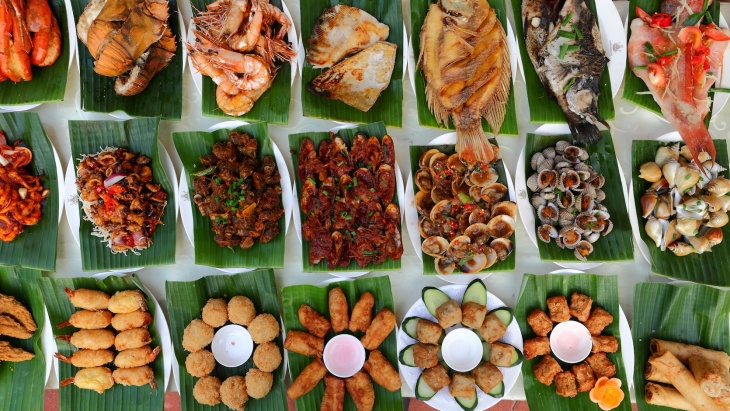
Nasi and mee
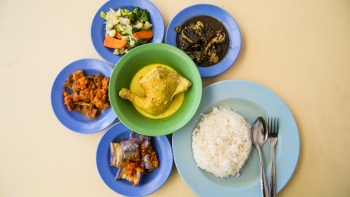
Founded in 1948, Warong Nasi Pariaman is famous for a humble mixed rice dish called nasi padang (steamed rice served with an assortment of side dishes) and is one of the oldest restaurants in the country to serve this delicious staple.
Take your pick from this restaurant’s many side dishes, which include beef rendang (braised meat cooked in coconut milk and spices) and sambal sotong (sliced squid in chilli paste). Be sure to arrive before or after lunchtime when seating is more likely to be available.
Warong Nasi Pariaman. 738 North Bridge Rd, Singapore 198706. +65 6292 2374.
Mon-Sat 10am-8pm; Sun 10am-5pm.
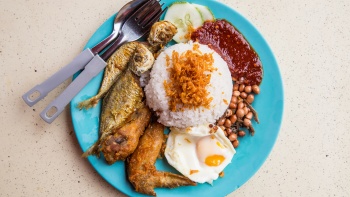
A satisfying mixed rice dish that’s often ordered by hungry locals on the go, nasi lemak (fragrant rice dish cooked in coconut milk and pandan leaf, accompanied by an array of side dishes like omelette, fried fish and anchovies) is highlighted by coconut-flavoured rice and fritters.
Famous nasi lemak outlets include Power Nasi Lemak at Boon Lay; and in Changi Village, where nasi lemak is sold by most hawkers here as either a fried fish set or a fried chicken set. The umami of this region, lemak is a flavour derived from the braising of meats, fish and vegetables in coconut essence, which is further accentuated by the liberal use of spices.
Power Nasi Lemak. 221B Boon Lay Place #01-106, Singapore 642221. +65 6266 4466.
Daily 4pm-4am
Changi Village Food Centre. 2 Changi Village Road, Singapore 500002.
Mon-Fri 6-2am; Sat-Sun open 24 hours.
As you might have guessed by now, “nasi” means rice in Bahasa Melayu. “Mee” is the Chinese dialect word for noodles, which Chinese traders introduced to the Austronesians. Adam Road Food Centre is the perfect venue for sampling Malay noodle dishes like mee soto, mee bandung and mee siam. The many tenured Malay tenants of this hawker centre purvey traditional renditions of the Indonesian chicken-based noodle soup mee soto; mee Bandung, whose name refers to the mix of ingredients in this spicy and tangy noodle soup; and spicy vermicelli dish mee siam, whose name reflects its Thai origins.
Adam Road Food Centre. 2 Adam Road, Singapore 289876.
Daily 7am-10pm.
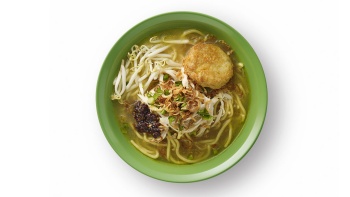
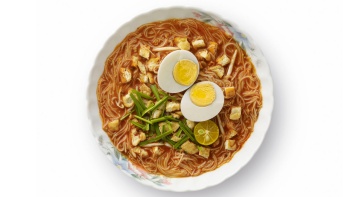
Goreng
Introduced to Southeast Asia by Chinese and Western traders, and subsequently used by the Malays to prepare a multitude of snacks, to ‘goreng’ is to deep fry. Visit the historic Malay neighbourhood of Geylang to enjoy samosas, a crispy triangle dish filled with spiced potatoes and other savoury fillings that can be bought from Geylang Serai Market, as well as the deep-fried banana treat goreng pisang. Locals vouch that for the best Malay-style curry puffs (meat or fish with potatoes wrapped in a fried dough crust), one must venture slightly down the road to Epok Epok Central.
Many hawker stalls sell the Malay style of fried chicken, ayam goreng kunyit, which is flavoured and yellowed with turmeric. The East Javanese rice meal nasi ayam penyet, whose name refers to its accompanying portion of flattened fried chicken, has also been adopted by Singaporean Malays and is best enjoyed in Lucky Plaza at restaurants like Ayam Penyet Ria.
Geylang Serai Market. 1 Geylang Serai, Singapore 402001.
Mon-Fri 6am-9pm; Sat-Sun 6am-10pm.
Epok Epok Central, Eunos Cresent Market & Food Centre. Block 4A Eunos Crescent #01-09, Singapore 402004. +65 9695 8899.
Tue-Sun 7am till approximately dinnertime.
Ayam Penyet Ria, Lucky Plaza. 304 Orchard Road #01-45/46/47 and #04-25/26/27, Singapore 238863. +65 6235 6390.
Daily 11am-9pm.
Satay
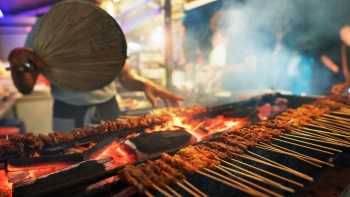 Photo by Danny Santos
Photo by Danny Santos Grilled meat skewers called satay, which is prevalent in most Muslim countries, is a comfort food that can be found at Satay by the Bay in the Esplanade area or on Satay Street that flanks Lau Pa Sat.
Satay by the Bay. 18 Marina Gardens Drive #01-19, Singapore 018953. +65 6538 9956.
Daily 11am-10pm.
Lau Pa Sat. 18 Raffles Quay, Singapore 048582.
Open 24 hours.
Desserts and kuih
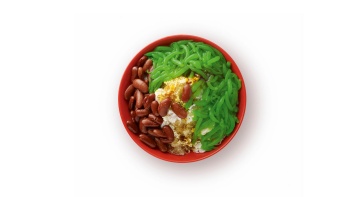
The Malays have a penchant for using tapioca, pandan, gula melaka, grated coconut and coconut milk to prepare kuih, which refers to a variety of small cake-like desserts. Treats like ondeh ondeh, which is a green kuih covered in coconut shavings and gula melaka filling, can be purchased from bakeries like KedaiKueKue. A bite-sized coconut cake filled with gula melaka, putu piring can be bought from Traditional Haig Road Putu Piring in the vicinity of Geylang, which teems with Malay kuih stalls.
After a day of food hunting, cool off with the shaved ice dessert chendol, which consists of pandan jelly moulded through a slotted spoon and immersed in gula melaka.
KedaiKueKue at Great World City. 1 Kim Seng Promenade #B1-K4, Singapore 237994. +65 6733 6788.
Daily 9.30am-9.30pm
Traditional Haig Road Putu Piring. 14 Haig Road, Singapore 430014. +65 9688 3067.
Daily 11am-10pm.
Whether you’re looking for cosy eateries, thrilling itineraries or places of worship in the neighbourhood, the Muslim Visitor’s Guide has got you covered! Download your copy here.